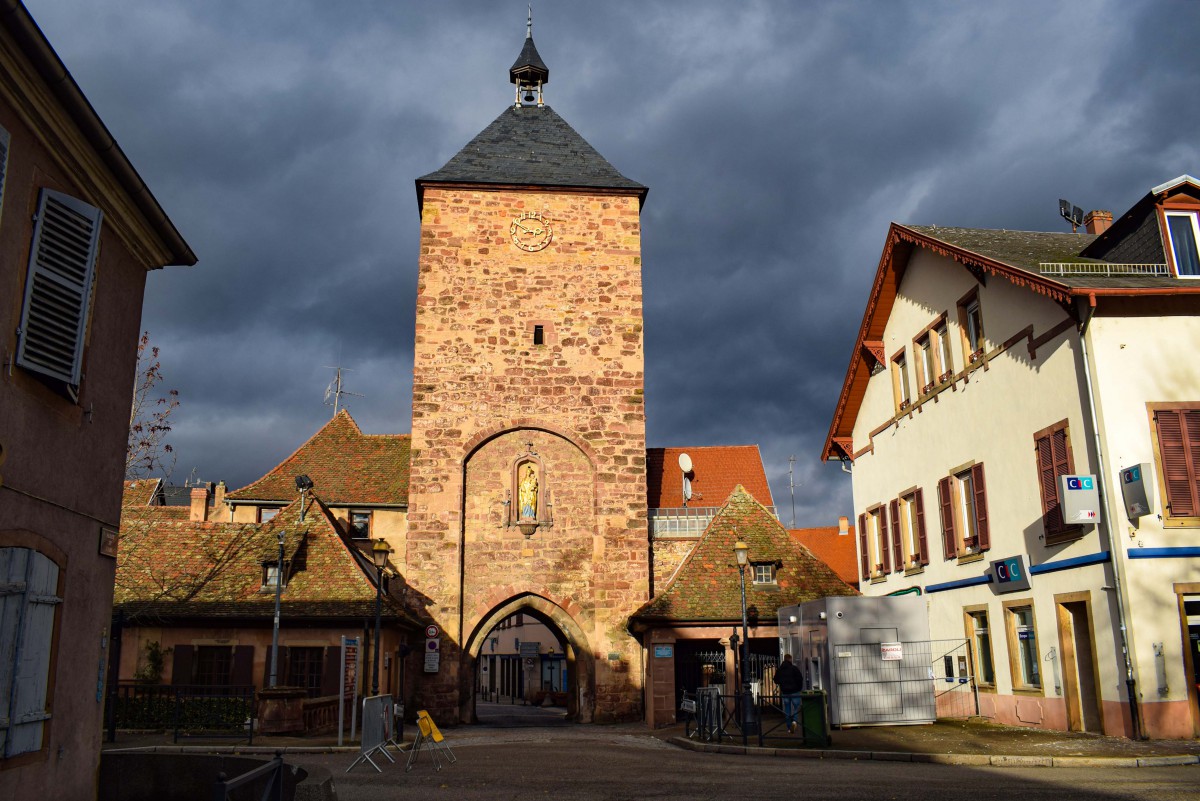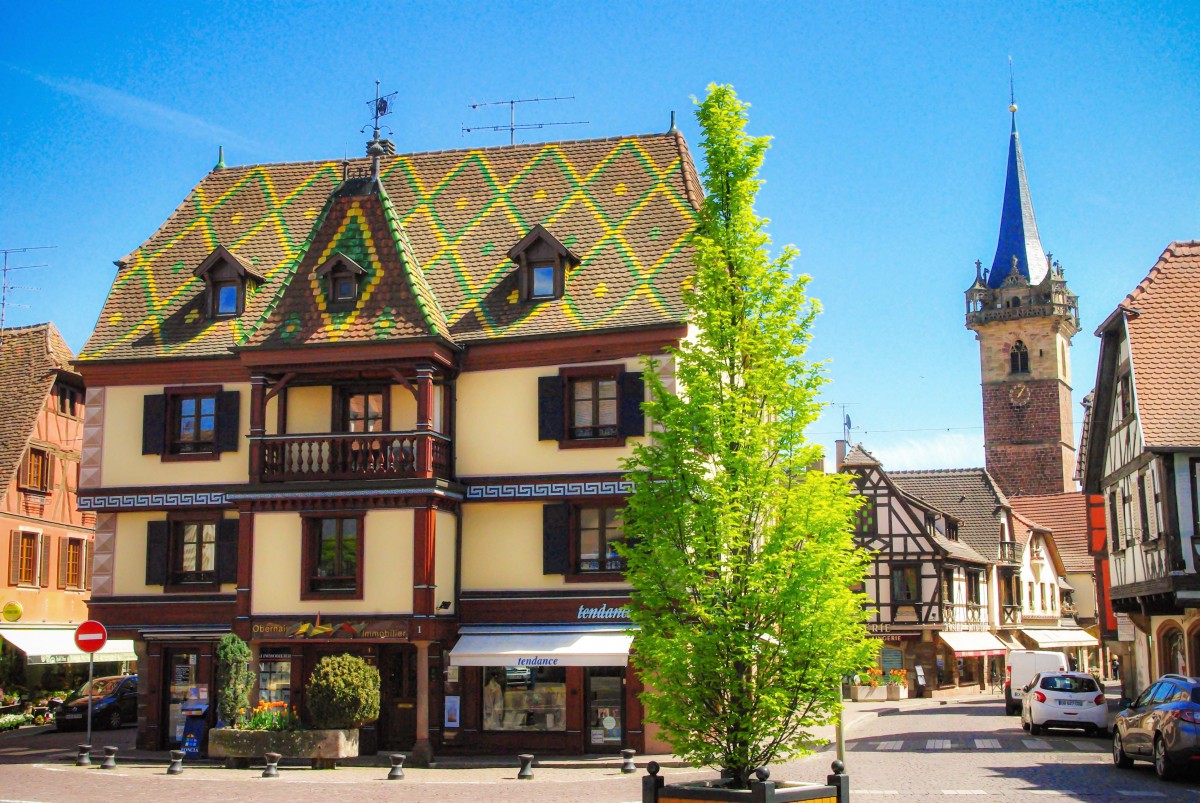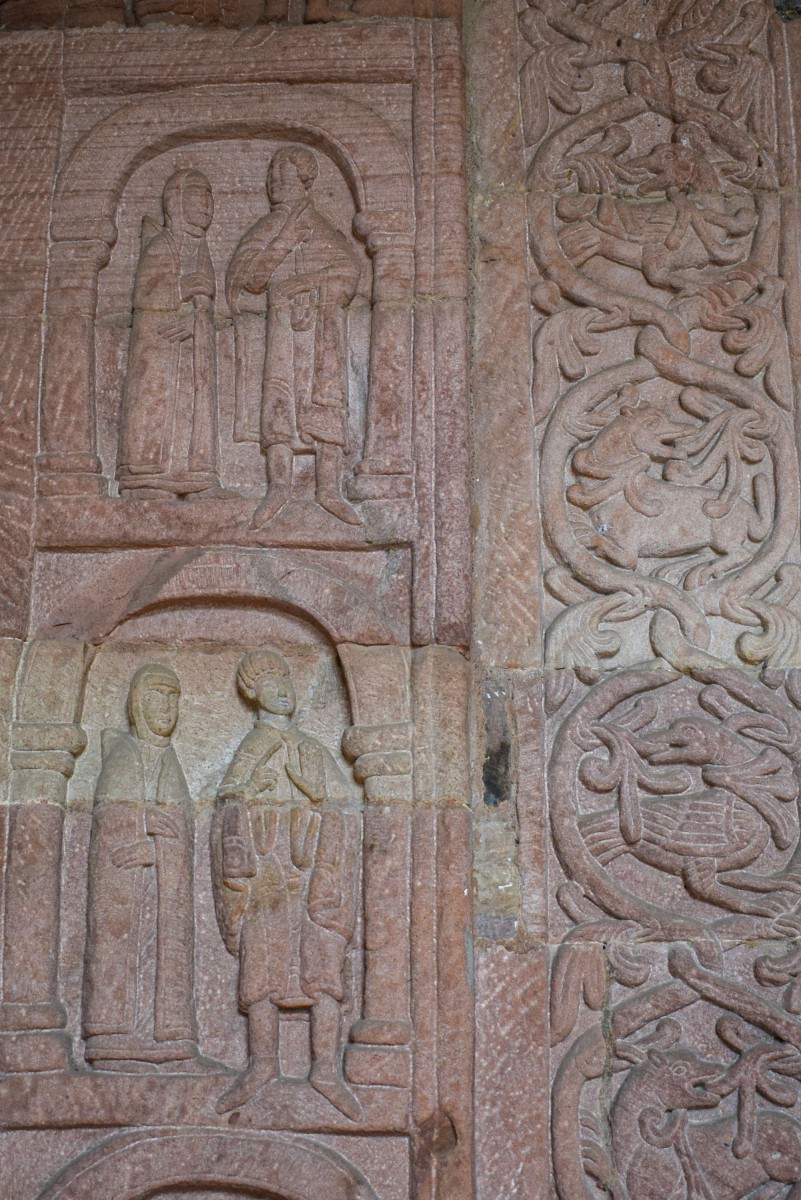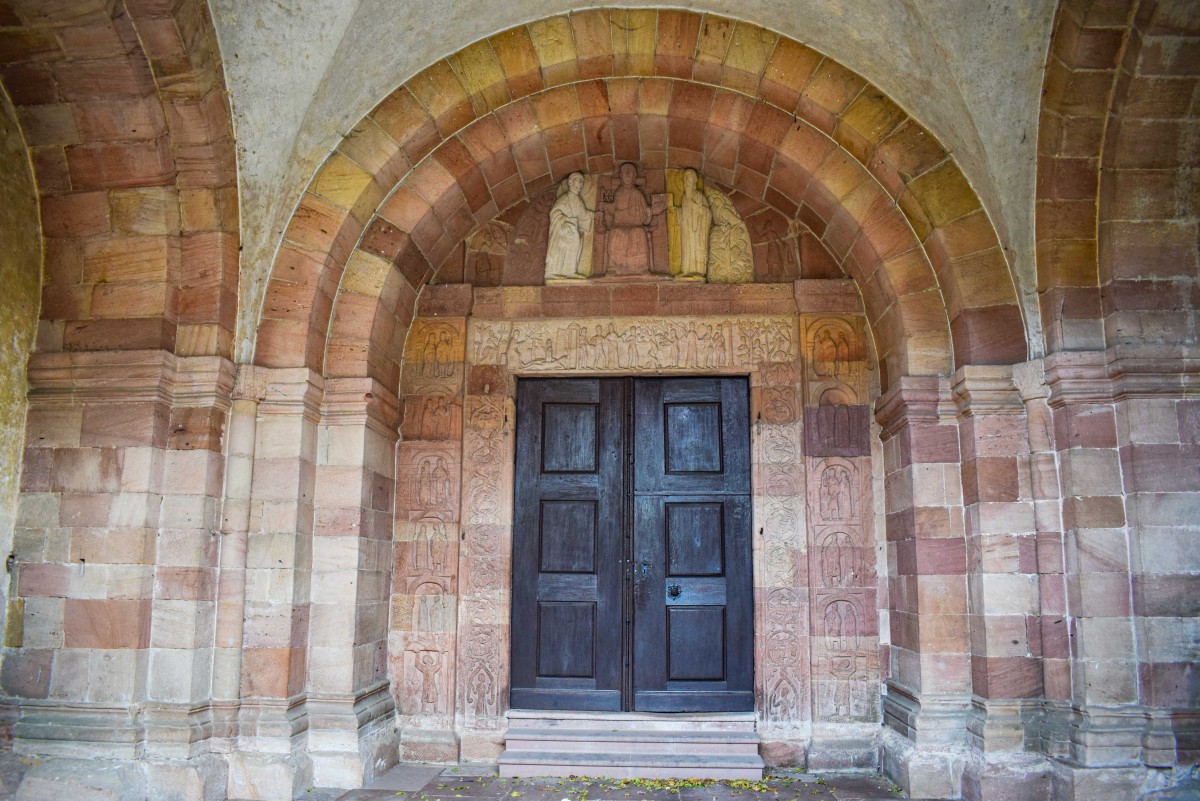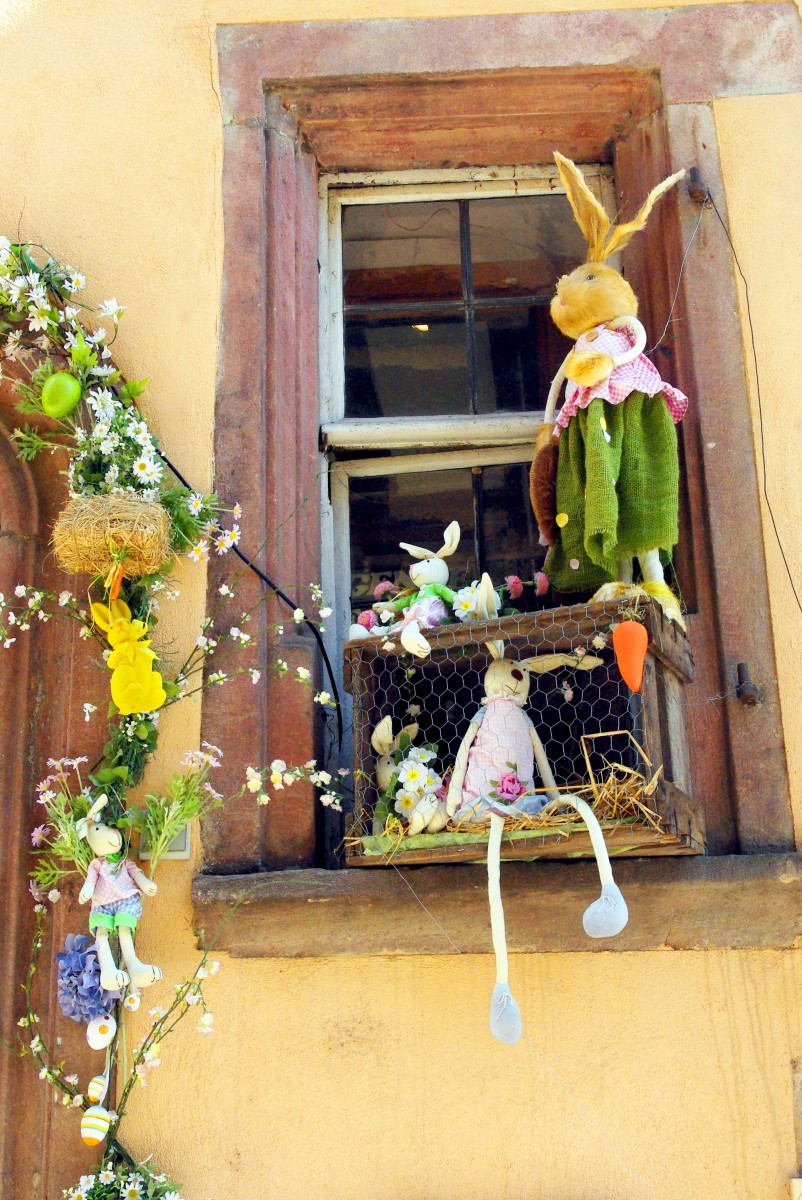The Alsace Wine Route, inaugurated in 1953, is a 170-kilometre journey through time and taste.
Winding its way through the heart of the Alsatian vineyards from north to south, it is undoubtedly one of France’s most stunning scenic routes.
Along the way, you’ll discover charming villages and picturesque countryside characteristic of the foothills of the Vosges, known as Le Piémont des Vosges.
Having lived in Alsace and explored this route numerous times, I can personally attest to its breathtaking beauty and unique charm.
Each visit reveals something new and enchanting, making it a truly unforgettable experience. For me, the Alsace Wine Route isn’t just a path through vineyards; it’s a journey through one of the most beautiful regions in France, filled with history, culture, and, of course, exceptional wines.
What is the Alsace Wine Route?
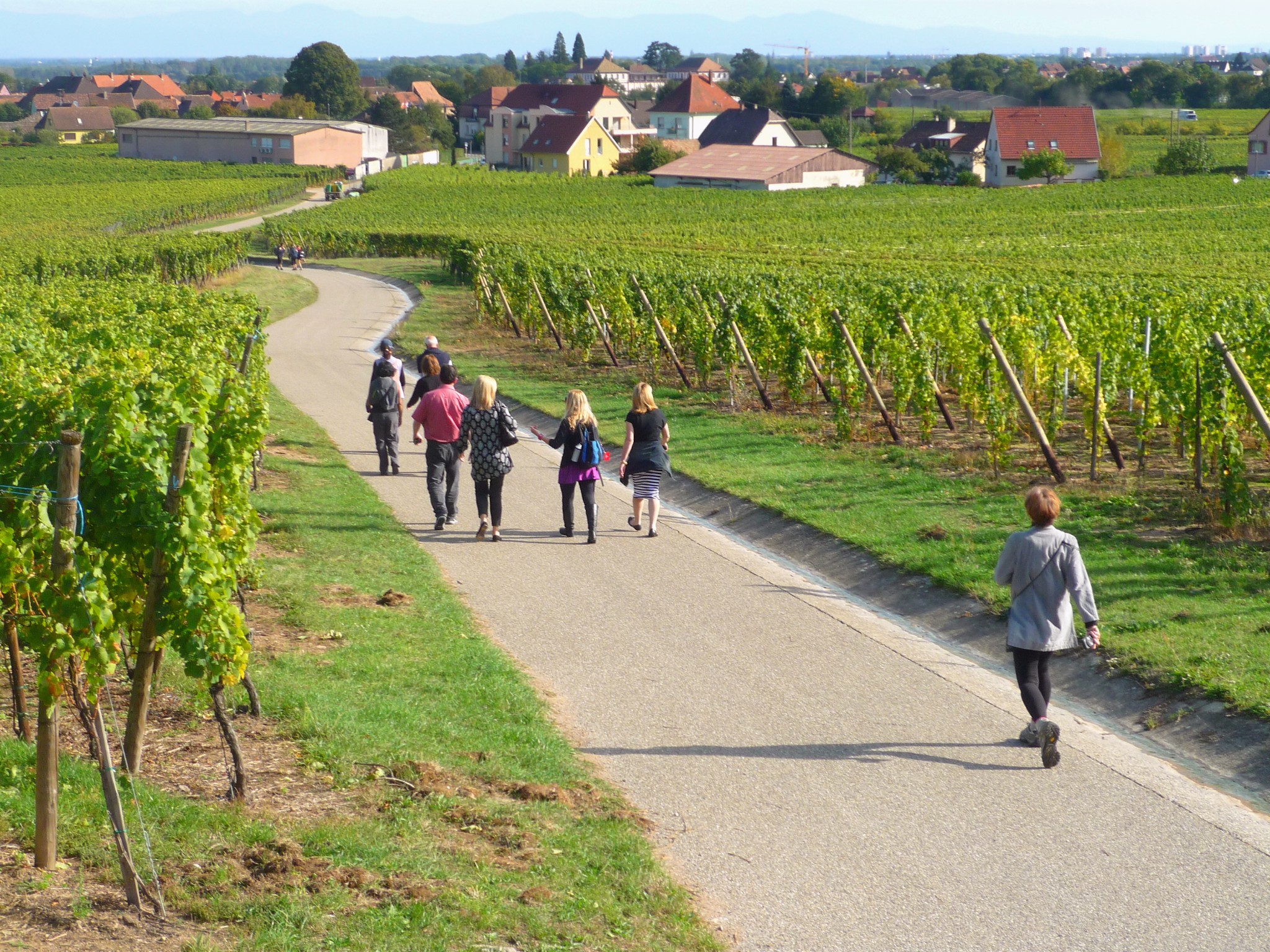
Several cities and villages along the Alsace Wine Route have since become famous and attract a very large crowd of visitors during the summer months and Christmas.
These gems of the wine country are often made up of old medieval ramparts, winding alleyways that bloom with magnificent geraniums, winstubs, vaults, half-timbered houses, and medieval churches.
In addition, many town names have become synonymous with rich traditions, friendliness, prosperity and great wines. These include:
- in the Bas-Rhin département: Marlenheim, Wangen, Molsheim, Rosheim, Obernai, Bœrsch, Mittelbergheim, Barr, Andlau, Dambach-la-Ville, Scherwiller, Châtenois and Kintzheim.
- in the Haut-Rhin département: Saint-Hippolyte, Bergheim, Ribeauvillé, Hunawihr, Zellenberg, Beblenheim, Riquewihr, Kientzheim, Kaysersberg, Ammerschwihr, Niedermorschwihr, Turckheim, Colmar, Eguisheim, Gueberschwihr, Rouffach, Guebwiller, Soultz-Haut-Rhin, Cernay and Thann.

The microclimates of the Alsace Wine Route
Benefiting from local microclimates, these areas are bordered:
- to the West by the natural barrier of the Vosges, and
- to the East by the Rhine Plain, which has its own sizeable natural border: the Black Forest in Germany.
The Romans, who introduced wine to Alsace and the Upper Rhine region, recognised the privileged position of the foot of the Vosges.
The region is indeed bathed in sunlight and protected from wind and rain by the mountains.
In particular, Colmar’s surroundings are one of the sunniest regions in France.
In fact, its average levels of precipitation are the lowest of all of France’s vineyards.
Once the Romans had left, it was only under the influence of monastic orders during the Middle Ages.
Viticulture enjoyed a new boom, and Alsace‘s reputable wines were exported to Nordic countries via the Rhine. In the 16th century, the Alsatian vineyard was twice as large as today.
23 not-to-miss villages on the route
The Alsace Wine Route winds through the Alsatian vineyards across several cities and villages.
We have chosen to describe in detail twenty-three of the most remarkable places along the tourist route from Marlenheim to Thann, including Molsheim, Obernai, Riquewihr, Kaysersberg, Eguisheim, and Rouffach. In the middle of the Route, Colmar, the capital of the Alsace wines, also deserves a closer look.
Marlenheim
The northern gateway of the Alsace Wine Route is located in the little town of Marlenheim, 20 km West of Strasbourg, which Marlenberg overlooks.

The vineyards have been famous since the 6th century and now stretch over 132 hectares, mostly planted with the Pinot Noir grape.
Marlenheim is built at the foot of Marlenberg Hill, the slopes of which enjoy an exceptionally sunny climate.
Set in the beautiful Marlenberg vineyards, the Marlenberg Chapel, with its imperial slate-tiled roof, dates back to 1683 and 1772.
The panoramic views from the top of the hill at 369 metres stretch over the Alsace Plain as far as the Black Forest range in Germany and the spire of Strasbourg Cathedral.
Pink sandstone was taken from a medieval quarry in Marlenberg to build the cathedral of Strasbourg.
Molsheim
In the Middle Ages, the town of Molsheim belonged to the bishops of Strasbourg.
Its site at the entrance of the valley of the Bruche gave the bishops a strategic position on the route to the Duchy of Lorraine.
In the 16th century, Molsheim was a major centre of the Counter-Reformation and was nicknamed the religious capital of Alsace.

The old part of town is well-preserved, and visitors will discover half-timbered houses bordering the narrow streets, typical of Alsatian architecture.
The old town includes many interesting monuments: the former monastery La Chartreuse (1598-1792), partly dismantled during the French Revolution; the 14th-century Tour des Forgerons (the most impressive remnant of the city wall); the baroque church of the Jesuits; the classical Town Hall; and the Metzig.
The Metzig of Molsheim
The Metzig is a Renaissance townhouse built in the 16th century for the butchers’ corporation.
While the vaulted ground floor was occupied by a butchers’ shop, the first floor, with its graceful balustrade balcony, housed the guild meetings.
The double carved-stone staircase leading to the first level is reminiscent of Mulhouse’s old Town Hall.
Facing the Place de l’Hôtel de ville, it is topped by an onion-shaped turret.
The Jacquemart Clock (1607) comprises two angels who strike the hours and quarter hours.
Today, Molsheim is a vibrant little city proud of being the historic place where Bugatti cars are manufactured.
The vineyards around the town produce the renowned Bruderthal wine.
Obernai

Believe it or not, the enchanting town of Obernai is the second most visited town of the Alsatian département of Bas-Rhin, after Strasbourg.
Obernai’s prosperous past is linked to the Decapolis, an alliance of 10 free Alsatian cities recognised in 1354 by Emperor Charles IV: Obernai, Kaysersberg, Haguenau, Colmar, Wissembourg, Turckheim, Rosheim, Munster, Sélestat, Mulhouse (replaced by Landau from 1515) and Seltz (from 1358 to 1414).
A military alliance and, something scarce at the time, financial aid in case of bankruptcy defined the Decapolis.
After Alsace joined France, Louis XIV ordered its dissolution in 1674.

The gems of Obernai
The old town includes some beautiful examples of restored medieval and Renaissance houses, many half-timbered houses.
You will see them in the streets around Place du Marché, ruelle des Juifs, Place de l’Etoile and rue des Pélerins.
Obernai’s most famous monuments are the Renaissance well of the six buckets (1579), the Kappelturm Belfry (60 metres high), the Town Hall (from 1370), the Corn Exchange Market (Halle aux Blés), dating back to 1554, and the remains of the medieval ramparts.
Mont Sainte-Odile
Obernai is located at the foot of the Vosges Mountains, near the popular Mount Sainte Odile (760 m), which the Hohenburg Abbey tops, consecrated to Saint Odile.

Read more about Obernai.
Barr

The picturesque little town of Barr is located 8 km south of Obernai, between the Vosges and the hilly vineyards.
With its old wine fair (more than 100 years old), Barr is one of Alsace’s wine capitals alongside Colmar.
The wine-growing town of Barr produces the famous Grand Cru du Kirchberg with Sylvaner, Riesling, and Gewurztraminer and holds a traditional Wine Fair (Fête des vendanges) on the first weekend of October in the Town Hall.
The fine Town Hall of Barr dates back to 1640 and was rebuilt on the foundations of an old 13th-century castle. It is embellished with a beautiful loggia and a carved balcony.
Life spirals around the Town Hall, set in the centre of the old town of Barr.
Typically Alsatian, with its cobbled narrow streets, most of it has been pedestrianised. During the summertime, it is worth a walk along the flower-decked streets bordered by ravishing half-timbered houses.
Just outside town, pathways meander through the vineyards toward the ruined medieval castle of Landsberg in the Vosges.
Andlau

The site of Andlau is remarkable: between the slopes of the Vosges and the Alsace Plain, the flower-decked village is well known for its vineyards.
This is the heart of the Riesling-producing area, with three famous vintages found nearby.
Once a powerful abbey
Andlau has a rich history linked to the presence of an abbey founded by Sainte Richarde in 880.
The old part of the village features houses from the 15th to the 18th centuries that belonged to winegrowers and tradesmen (blacksmiths, carpenters, butchers…).
The village is surrounded by two ruined castles: the Spesbourg and the Haut-Andlau. The former is easily recognisable by its two cylindrical keeps flanked on both ends of the building.
Andlau is also a gateway to the Champ du Feu massif (1,100 metres) in the Vosges and to the holiday resort village of Le Hohwald.
Andlau Tourist Office: http://www.pays-de-barr.com/
Dambach-la-Ville

Although probably not as touristy as the neighbouring villages, Dambach-la-Ville is worth a visit with its postcard-perfect vista of ramparts, church spires, gateways, and colourful and flowered half-timbered houses.
The rampart built by the Bishops of Strasbourg dates back to 1325.
With some 60 wine cellars, Dambach-la-Ville has become the largest wine-producing village in Alsace today. Its vineyards produce one of the finest Alsatian wines: the renowned Frankstein Grand Cru.
In the vineyards
Outside the village, marked pathways meander among the vineyards towards the iconic chapel Saint Sébastien.
The historic church features a Romanesque belltower, a Gothic nave and apse and a 17th-century baroque altar.
From there, the view extends to Sélestat, the Alsace Plain, the Kaiserstuhl and the Black Forest in Germany.
In fine weather, it is possible to glimpse the spire of Strasbourg Cathedral.
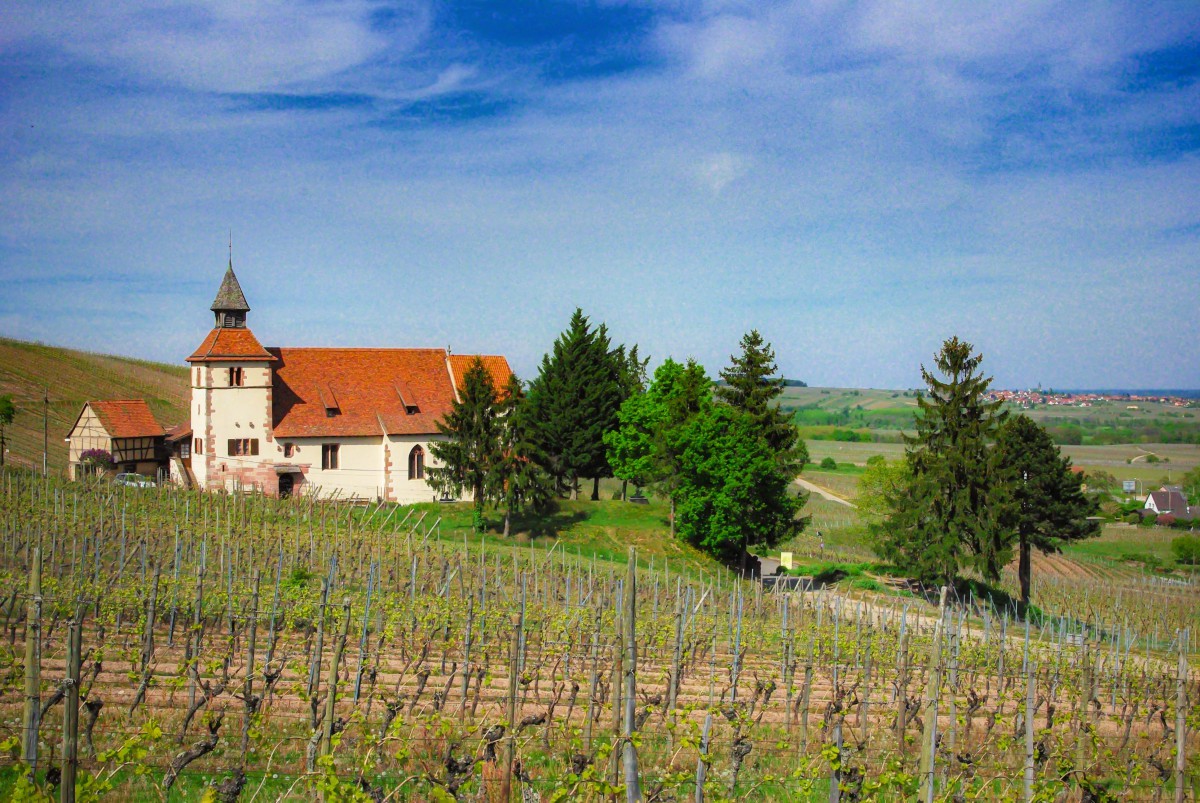
Read more about Dambach-la-Ville.
Scherwiller

Surrounded by vineyards, the village of Scherwiller is a gate to the valleys of Sainte-Marie-aux-Mines and Villé.
This strategic situation explains the presence of two medieval castles in ruins: the Ramstein and the Ortenbourg.
The scenic Alsatian Wine Route crosses Scherwiller and is famous for the half-timbered guardhouse (18th c).
Châtenois

From Châtenois to Eguisheim, the Alsace Wine Route enters its most famous stretch as it crosses some of Alsace’s reputed villages and cities such as Ribeauvillé, Hunawihr, Riquewihr, Kaysersberg, and Colmar.
The village of Châtenois is 4 km from the town centre of Sélestat, on the route to Saint-Dié-des-Vosges and Nancy in Lorraine.
There are a few interesting monuments to discover in Châtenois: the singular Romanesque bell tower of the parish church with its spire based on four timber bartizans, the Witches’ Tower (Tour des Sorcières) crowned by a stork’s nest and a few fine half-timbered houses.
Find out more about Châtenois.
Kintzheim
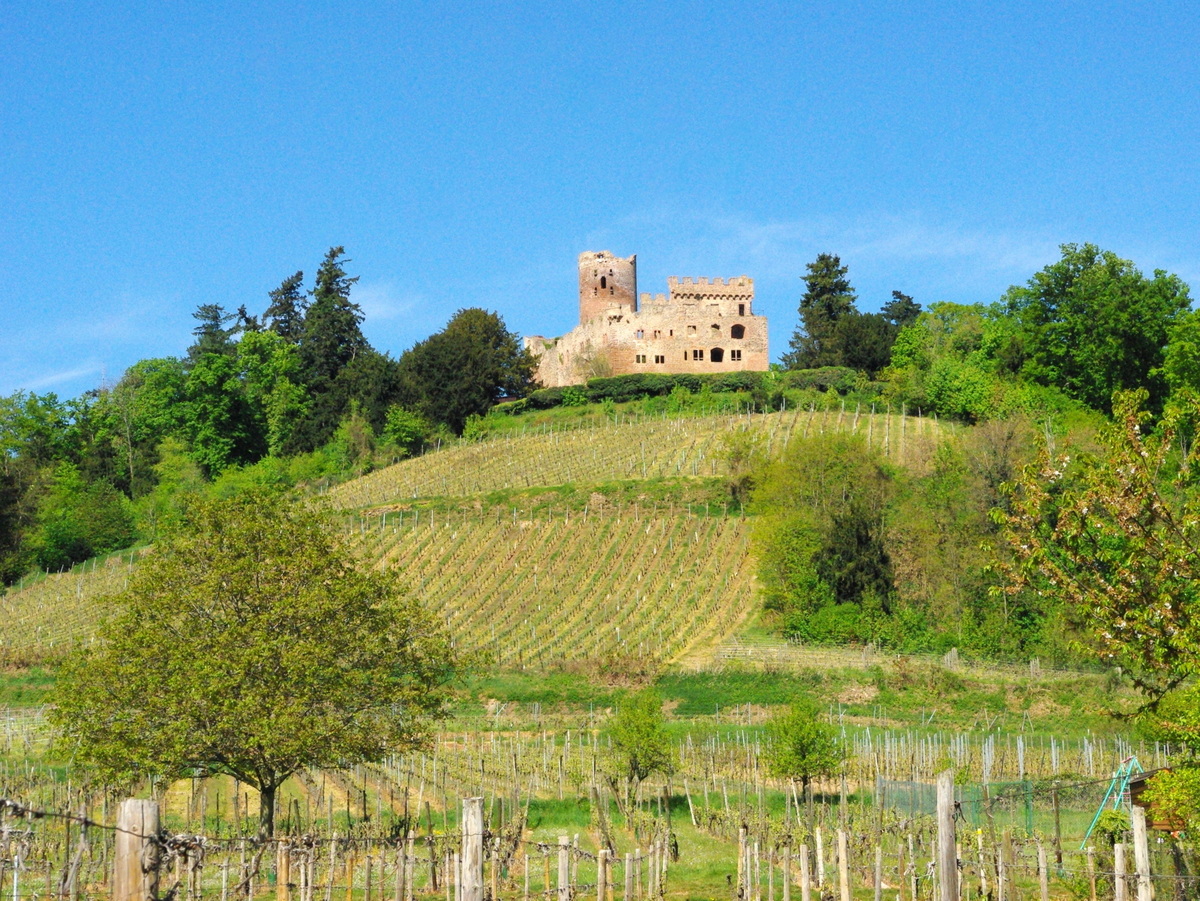
The village of Kintzheim is a popular stop on the Alsace Wine Route, particularly for the three main recreational sites: the Montagne des Singes, the Volerie des Aigles, and Cigoland.
In addition, the village is located close to the Haut-Kœnigsbourg Castle.
Find out more about Kintzheim.
Saint-Hippolyte

This attractive and flowery village, encircled by vines and sturdy ramparts, is at the foot of the majestic medieval castle of Haut-Kœnigsbourg.
13th-century ramparts surround the little wine-producing town – but out of the four original defence towers, only one still stands today, the Stork’s Tower (Tour des Cigognes). A marked path follows the line of the fortified walls around the outside of town.
In the centre of Saint-Hippolyte, beautiful half-timbered houses dating back to the 16th century are completed by the 14th-century parish church (whose bell tower added in 1822 resembles an Italian church) and flower-decked fountains.
Saint-Hippolyte Tourist Office: http://www.ribeauville-riquewihr.com/
Bergheim

Coming from Saint-Hippolyte, the fortified village of Bergheim suddenly appears at a curve of the Alsace Wine Route.
Located in a beautiful landscape of undulating wine-growing hills, Bergheim is known as one of the rare towns in Alsace to have kept its fortified walls intact, dating back to 1311.
The history of Bergheim is quite turbulent.
The village prospered rapidly during the Middle Ages under the authority of the Ribeaupierre, Lords of Ribeauvillé, before suffering from the consequences of stampeding invasions.
Between 1582 and 1683, many witch trials occurred in Bergheim, which resulted in 40 women being burnt at the stake for witchcraft.
The Witches’ House (Maison des Sorcières) recounts the events of the trials to reflect on the questions of exclusion and intolerance.
The ramparts of Bergheim
It is possible to walk outside the fortified walls along a 2km path parallel to Bergheim’s ramparts.
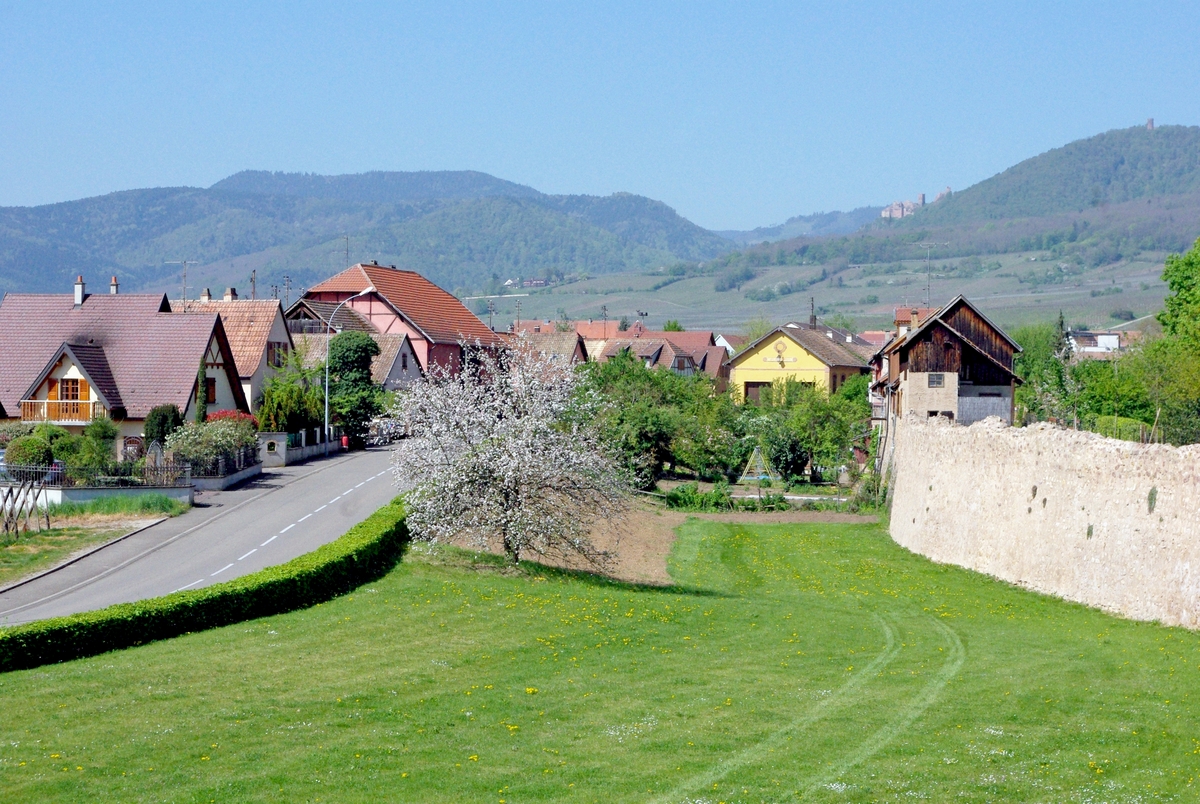
The well-preserved centre of the village features some fine monuments and half-timbered houses.
At the western entrance of the village, the imposing and turreted Porte Haute is Bergheim’s only remaining gate, dating back to the 14th century.
With its winding streets bordered by wine-growers’ houses and wrought-iron signs, Bergheim has become an inevitable stop along the Alsace Wine Route.
Read more about Bergheim.
Ribeauvillé

A central tourist hub along the Alsace Wine Route, the town of Ribeauvillé is framed by the fantastic scenery of vineyards and rolling hills on the Vosges’ edge.
The mountain flanking the town is crowned by three ruined feudal castles, giving this site an enchanting touch.
Renowned for its Riesling and Gewurztraminer white wines, the vineyards of Ribeauvillé produce local Grands Crus Kirchberg, Osterberg and Geisberg.
The semi-pedestrianised street of Grand’Rue acts as the spinal cord of the town.
Most of Ribeauvillé’s finest houses and monuments are found along the narrow main street, including the 13th-century Butchers’ Tower (Tour des Bouchers), which separates the lower and higher parts of town.
Other houses of interest are the Pfifferhüs (former house of the fife-playing minstrels), the Halle au Blé (covered corn exchange hall), the Elephant Inn from 1522, the 18th-century Town Hall and its small museum with a prestigious collection of silver and gold items.
The Three Castles of Ribeauvillé
Ribeauvillé and its vicinity were the possession of the powerful Lords of Ribeaupierre, a local dynasty that built the three castles which still dominate the town.
The ruins are accessible by hiking footpaths from the town.
The Saint-Ulrich castle is by far the most impressive, although the smallest at 528 metres.
Saint Ulrich is also the oldest: its construction started in the 11th century.
The castle features three architectural styles: Romanesque, Gothic and Early Renaissance.
The Girsberg castle, built in the 13th century by the Ribeaupierre, was given to house the knights of Girsberg in 1304.
The Haut-Ribeaupierre castle is the highest of the three at 642 metres.
Only the circular keep stands today, on top of which there is a commanding view over the Alsace Plain and the Black Forest (Germany) in the distance.
Read more about Ribeauvillé.
Hunawihr

Hunawihr, one of France’s most beautiful villages, is renowned for its iconic fortified church, which overlooks the village, the vineyards and the Alsace Plain.
Hunawihr was founded by Hunon (Lord of the Franks) in the 7th century, to whom it owes its name.
An old cemetery and 14th-century walls surround the fortified church Saint Jacques le Majeur.
Its square bell tower is as strong as a keep and dates back to the 14th century.
The church is used for combined Catholic and Protestant services.
The fountain and washhouse at the village’s entrance provide a fine view of the fortified church above and the three castles of Ribeauvillé in the distance.
Read more about Hunawihr.
Riquewihr

Listed among the most beautiful cities in France, Riquewihr is rightly the pearl of the Alsatian vineyards.
The village, with countless half-timbered houses, attracts millions of visitors each year, especially in summer and as the festive season approaches.
The shades of the half-timbered houses are typical of Alsace: red, green, or bright yellow.
They add a very picturesque stamp to the site (some rumours say that it is a mini Disneyland!).
Read more about Riquewihr.
Beblenheim

A little away from the touristic sites of the Alsace Wine Route, Beblenheim is a charming wine-growers village with several half-timbered houses dating back to the 17th century.
Walk along with rue Jean Macé to marvel at a beautiful floral display on the façades of old houses.
Read more about Beblenheim.
Kientzheim
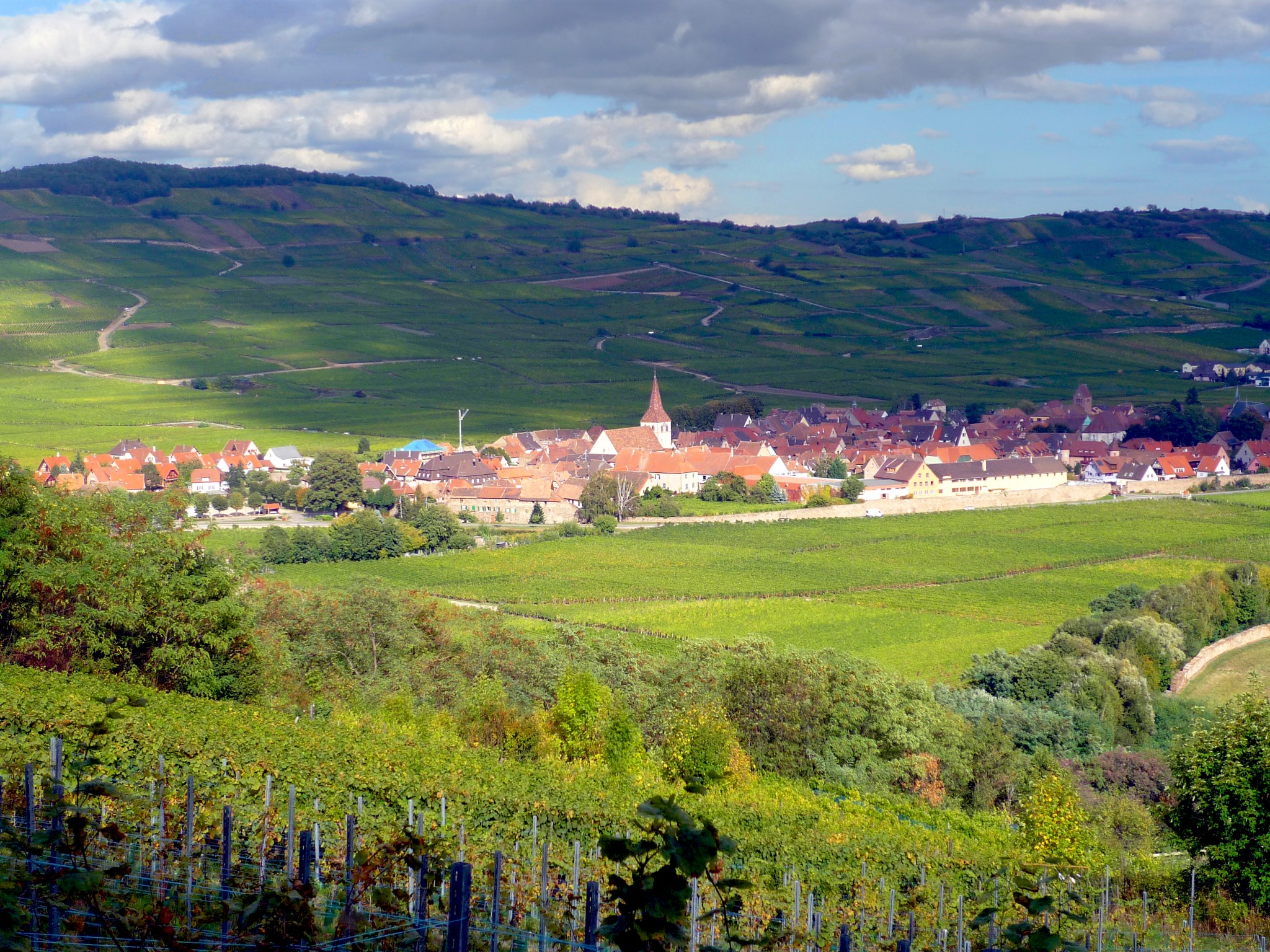
At the foot of the undulating hills covered by vineyards, the wine-growing town of Kientzheim is located between the top-rated sites of Riquewihr and Kaysersberg.
Founded in the 8th century, Kientzheim is still surrounded today by its ramparts.
Read more about Kientzheim.
Kaysersberg

Kaysersberg, the “Mountain of the Emperor,” certainly deserves its prestigious name.
A tourist hotspot, the little city’s entirely pedestrian centre houses the most beautiful half-timbered houses of the Renaissance in Alsace.
The city of Kaysersberg and its viticulture are dominated by the castle ruins, which now consist only of a beautiful round tower.
The view from its summit offers a panorama of the city, the valley of the Weiss, the vineyards, and the Plain.
Read more about Kaysersberg.
Niedermorschwihr

Between Turckheim and Katzenthal and 6 km from Colmar, the village of Niedermorschwihr (pop. 540) was first mentioned in 1148.
During the fights in the Pocket of Colmar, 60% of the village’s houses were destroyed in December 1944.
The parish church is the most iconic monument of Niedermorschwihr. It has the particularity to have a unique crooked spire.
The village’s narrow old streets are bordered by many beautiful stone and half-timbered houses from the Renaissance era and the 18th century.
The vineyards of Grand Cru Sommerberg surround Niedermorschwihr.
Find out more about the village of Niedermorschwihr.
Turckheim
When French people outside Alsace hear the name Turckheim, they usually think of actress Charlotte de Turckheim.
However, they may not know that there is a fine medieval town of the same name in Alsace.
In fact, the popular French actress’ ancestors came from the nobility of Turckheim.
The town of Turckheim commands the entrance to the valley of Munster and the route towards Lorraine beyond the pass of Col de la Schlucht.
It enjoyed a strategic position during the Middle Ages, so it is not surprising to find remnants of fortified structures.

Three distinctive gateways access the medieval ramparts that still surround Turckheim:
- the Munster Gate (through that gate, the tortured witches were led to the square to be burnt at the stake),
- the Brand Gate (opening onto the vineyards, it was carefully kept locked, except during the grape harvest season),
- and the France Gate (the gate for trading, mainly with Switzerland).
In the town centre, many buildings reflect Turckheim’s prosperous past.
The historic town was indeed a member of the Decapolis: the Guardhouse, the Town Hall, the parish church, and several half-timbered houses.
Find out more about Turckheim.
Colmar
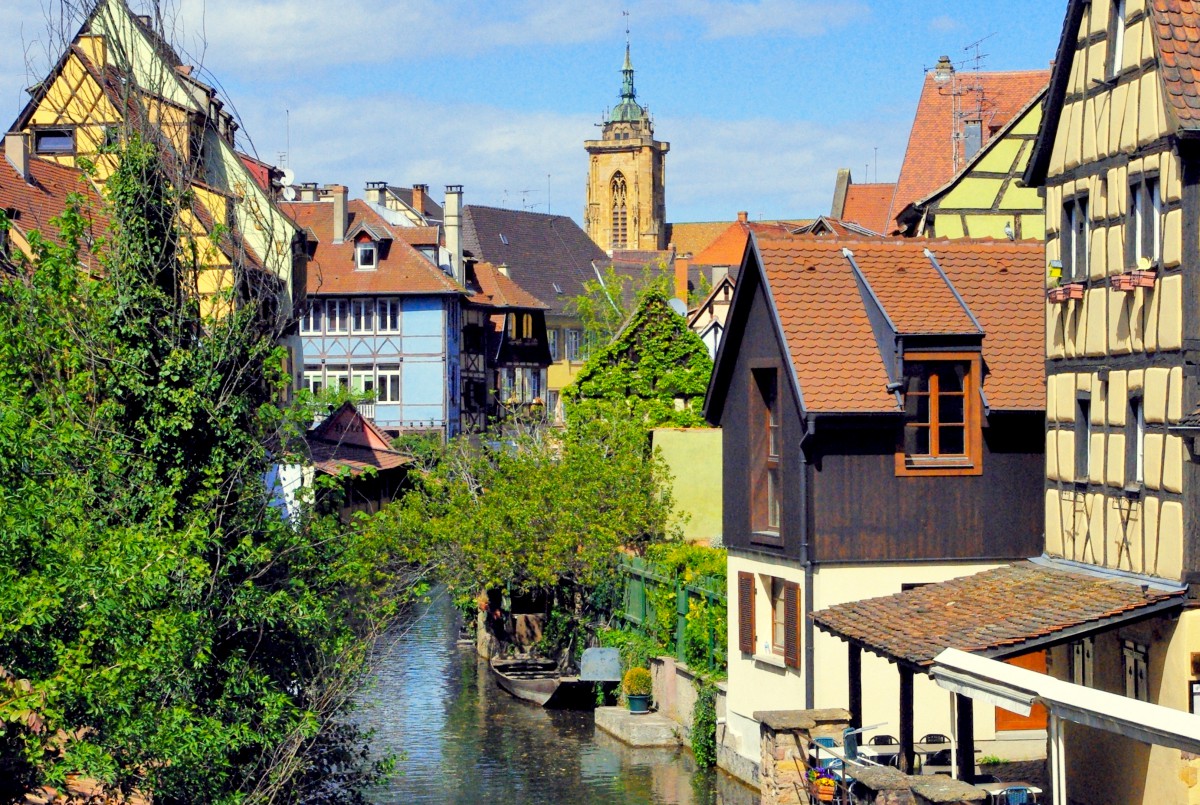
At the heart of the Alsace Wine Route, Colmar is very well located, and while it may not be the capital of Alsace, it remains one of its top tourist destinations.
The city has a rich architectural and cultural heritage that is impressive for its size (80,000 inhabitants in its metropolitan area).
Its numerous half-timbered houses neatly line the cobblestone streets and walkways, its peaceful canals give it its reputation as the “Little Venice of Alsace,” its museums rich in altarpieces and artistic masterpieces of Gothic and Renaissance art, and its delicious restaurants offering some of the best cuisines in the region are all the assets the city needs to perfect and maintain its international reputation.
Read more about Colmar.
Eguisheim
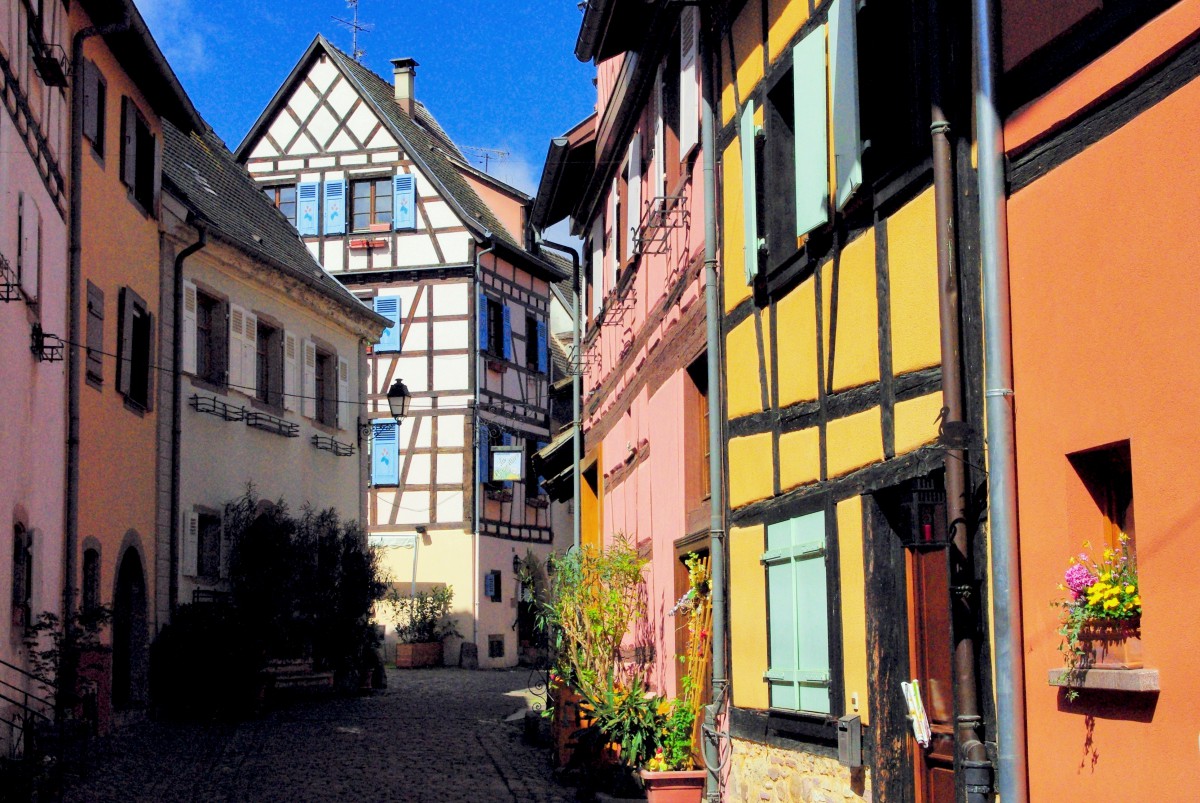
When looking at a photo of Eguisheim taken from above, it is easy to be amazed by the shape of this medieval city, built in three concentric circles around the octagonal Romanesque chateau.
This birthplace of the Alsatian vineyards was listed as one of the Most Beautiful Villages in France in 2003 and has been awarded the National Grand Prize winner for Flowers since 1989.
Located only 5km from Colmar, Eguisheim is surrounded by a 339-hectare vineyard, whose hills “Eichberg” and “Pfersigberg” are classed among the “Great Wines” of Alsace.
Read more about Eguisheim.
Husseren-les-Châteaux

Husseren-les-Châteaux is situated above the village of Eguisheim.
It is dominated by the three ruined castles of the counts of Eguisheim strategically placed atop a mountain of the Vosges: the Wahlenburg, the Weckmund and the Dagsburg.
At 390m high, Husseren is the highest point of the Alsace Wine Route.
Its name derives from the old German ‘Husen’ (at the houses), and the village was first mentioned in 1247.
Its history is linked with the local noble dynasty of the Hattstatts and then of the Schauenburgs, a noble family from Lower Saxony.
The village and the surrounding vineyards offer a panoramic view of Vosges, Colmar, the Plain of Alsace and the Black Forest mountains in Germany.
Obermorschwihr

The village of Obermorschwihr was first mentioned in 913 under the name of Morsvilare in a charter made by the bishop of Strasbourg.
In 1090 a priory was founded there which would later be known as the abbey of Marbach. The village was owned by the bishop of Strasbourg until the French Revolution.
The parish church devoted to St. Philip and St. James has a distinctive half-timbered bell tower from 1720.
Hattstatt
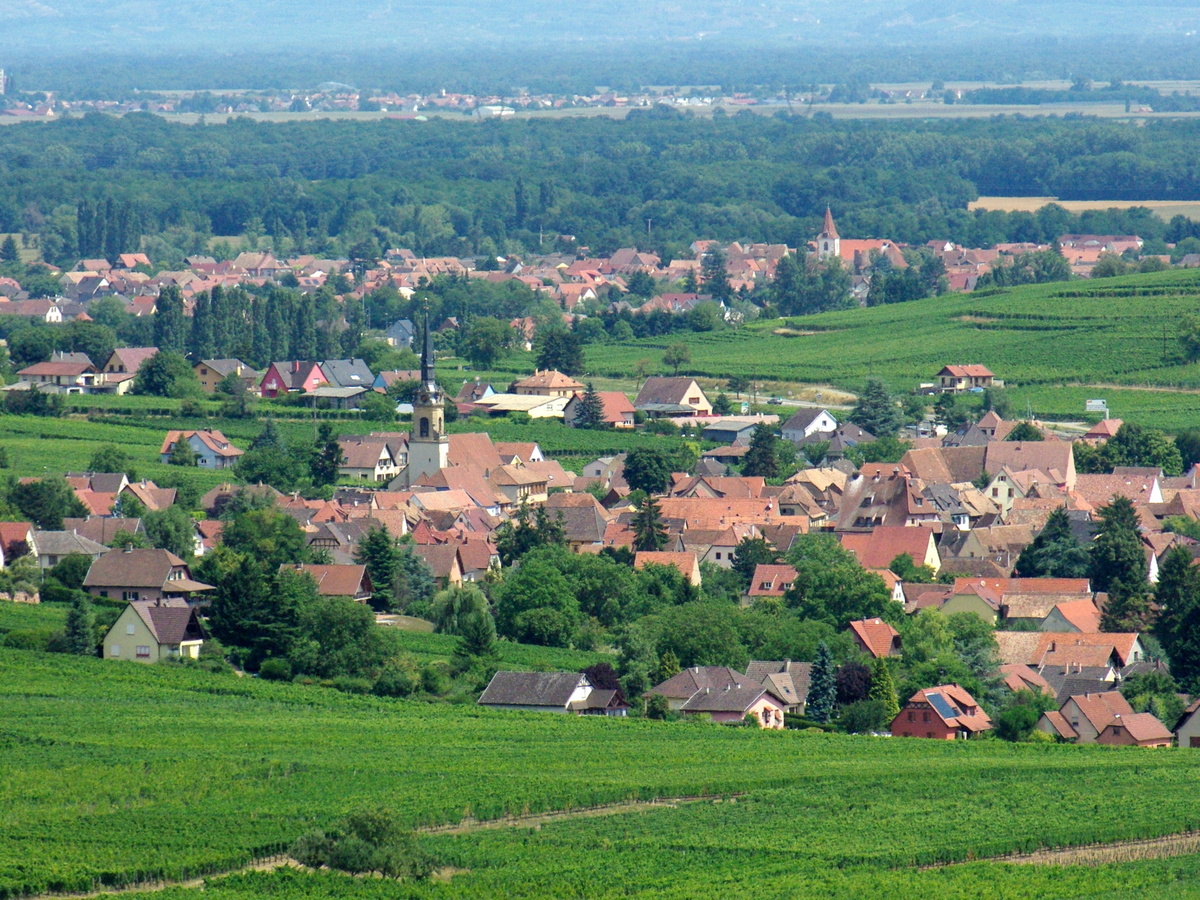
Hattstatt (pop. 800) is an old wine village whose name derives from Hatton (or Otto), the site’s first owner.
In the 12th century, a noble family, the Hattstatts took over the control of the village.
The dynasty was momentarily forced to leave the village to the bishop of Strasbourg from 1294 to 1460.
After the Hattstatts died in 1587, the village passed into the hands of a noble family from Switzerland, the Truchsess of Rheinfelden and later the Schauenburgs from Lower Saxony.
The village became part of the Kingdom of France in 1648 at the signature of the Treaty of Westphalia.
The village of Hattstatt houses the Sainte Colombe Church (11th-18th centuries) and many wine-grower houses from the 16th to the 18th century.
Gueberschwihr

Overlooking the Plain of Alsace, Gueberschwihr is a beautiful village ideally set between the foothills of the Vosges and the vineyards.
The village was first mentioned in 728.
Its name is believed to derive from the old German ‘Gebel,‘ meaning gable.
During the Middle Ages, the bishop of Strasbourg owned the village.
The state or local council lists more than 78 monuments or houses, including the fine Romanesque church devoted to St. Pantaléon.
Rouffach

Fifteen kilometres South of Colmar, Rouffach is a small town of fewer than 5,000 inhabitants, first mentioned in the 7th century.
Today, the town is worth a stop along the Alsace Wine Route to visit its picturesque centre.
Rouffach’s principal monuments include the Church of Notre-Dame de l’Assomption, the old Corn Exchange and the medieval Witches’ Tower (Tour des Sorcières).
The castle of Isenbourg is on top of a small hill covered with vineyards and overlooks the little town.
It houses a luxury hotel and restaurant.
Finally, Rouffach’s vineyards are renowned for producing the Vorbourg Grand Cru, one of Alsace’s finest wines.
Find out more about Rouffach.
Guebwiller

Halfway between Mulhouse and Colmar, Guebwiller is a lively town at the entrance of the Florival Valley.
Owned by the powerful Abbots of Murbach during the Middle Ages, Guebwiller often suffered from the conflicts between the churchmen and the Habsburg.
From that troubled – but yet prosperous – history, Guebwiller retains some interesting monuments, particularly churches:
- the Church Saint-Léger (12th-13th centuries), of late Rhenish Romanesque style,
- the Dominican Abbey and cloister, of Gothic style,
- the Church Notre-Dame de Guebwiller (1762-1785) of neo-Classical style.
Five kilometres deeper in the Florival Valley stands the remaining structures of the former Murbach Abbey. Only the transept remains with its two towers and the east end with the choir.
Guebwiller Tourist Office: http://www.tourisme-guebwiller-soultz.com/
Soultz-Haut-Rhin

Merging into neighbouring Guebwiller, the town of Soultz comprises an old, well-preserved city partly surrounded by medieval ramparts.
There are several fine houses in the old town to admire.
Fifteen dates back to the 16th century (1515-1590).
The former seat of the episcopal bailiff (1289 to the French Revolution) was housed in the 11th-century Buchenek fortress, now a local history museum.
The parish church, built between 1270 and 1489, features a bell tower above the transept’s crossing.
The town of Soultz takes its name from a salted water spring.
“Haut-Rhin” was added later to avoid confusion with Soultz-sous-Forêts and Soultz-les-Bains in northern Alsace.
Soultz-Haut-Rhin Tourist Office: http://www.tourisme-guebwiller-soultz.com/
Cernay

The final stage of the scenic Route des Crêtes of the Vosges, Cernay is a small industrial town with a few interesting medieval buildings in its historic centre, including the Thann Gate (Porte de Thann), which hosts the local history museum.
Visit the Tourist Board of Haute-Vosges Alsace for more info about Cernay.
Thann

The Alsace Wine Route ends in Thann, a historic town renowned for its Gothic church and the vines growing on the slopes of the Rangen mountain.
Thann was an Austrian stronghold until 1648, commanding access to the Duchy of Lorraine through the Col du Bussang.
At the entrance of the historic part of town stands the Saint-Thibault Collegiate.
The Gothic sanctuary is arguably Alsace’s most richly decorated church. A local saying tells us that:
“if the spire of Strasbourg Cathedral is the tallest, and if the spire of Freiburg cathedral is the broadest, then the spire of Thann collegiate is the prettiest!”
The church (14th-16th centuries) displayed a remarkable example of the Flamboyant Gothic style.
In addition, the old town of Thann is worth a visit.
Its stoned houses differ greatly in style from the half-timbered ones seen from Rouffach and further north.
The Angels Castle…
Above the town lie the ruins of Thann’s feudal castle, the Engelbourg Castle, also locally nicknamed the Witch’s Eye (l’œil de la Sorcière).
When Louis XIV ordered its dismantlement, one of the towers fell and overturned to form a large stone ring.
The former tower was kept as such, standing oddly amidst the ruins.
When arriving in Thann, the Route des Crêtes offers a pleasant journey along the ridges of the Vosges’ highest summits northwards to Sainte-Marie-aux-Mines, from where you can easily reach Sélestat and Strasbourg.
Find out more about Thann.
The Christmas Markets along the Alsace Wine Route
The Christmas Markets are a real institution deeply rooted in Alsatian tradition.
When Advent arrives in Alsace, cities and villages are decorated for the occasion.
The streets are adorned with sparkling decorations, animated facades, and illuminated monuments.
Little wooden chalets are raised in the town centre of Riquewihr, Kaysersberg and Eguisheim.
The stalls are individually decorated and illuminated to spread the enchanting atmosphere of the Alsatian villages.
The Alsatian Christmas markets begin at Advent and finish shortly before Christmas.

The Authentic Christmas markets
A true Alsatian Christmas market displays the Christmas nativity scene with a majestic illuminated Christmas tree.
The delicate aromas of mulled wine (with scents of cinnamon, orange and spices) and roasted chestnuts perfume the atmosphere.
The craftsmen in the chalets offer authentic goods, especially for the Christmas season: decorations for the Christmas tree, pottery decorations, blown glass, toys and chiselled wooden Christmas figures for the nativity, linen, floral art, and hampers containing foie gras, Christmas biscuits and gingerbread.

Hugely popular, the Christmas markets of the villages along the Alsace Wine Route can become congested with visitors on weekends in December—you had better come armed with patience!
Learn more about Christmas celebrations in Alsace on our page: Christmas in Alsace.
How to get to the Alsace Wine Route

The Route des Vins d’Alsace is easily accessible by car from Strasbourg, Colmar, and Mulhouse, as well as Lorraine (Nancy and Metz) and Franche-Comté (Besançon).
From Paris, take the N4 road (a dual carriageway from Vitry-le-François to Nancy) and then the expressway from Nancy to Saint-Dié des Vosges.
If you travel from America or Australia, you could fly to Paris Charles de Gaulle, Zurich or Frankfurt Airports and rent a car there.
The TGV from Paris-Gare de l’Est takes just 2 hours to Strasbourg and stops at Colmar and Mulhouse.
Have you ever visited any of the villages on the Alsace Wine Route? If so, please share your experiences in the comments below.
Pin this for later…





